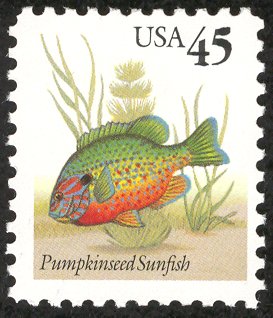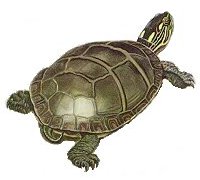Largemouth Bass
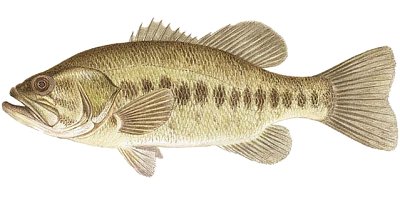
Micropterus salmoides
Size
to 38"
This is an introduced species in New Jersey, although it occurs in regions all around. Largemouth bass at Dutch Springs are as tame as dogs, and will follow you around hoping for handouts, as long as you don't spook them. If you don't happen to have anything to feed them, a good way to keep their interest is to flip over rocks on the bottom, exposing tasty little crayfish and other treats that the bass will go right after.
The largemouth is the largest member of the sunfish family. It generally has light greenish to brownish sides with a dark lateral line which tends to break into blotches towards the tail. Often confused with smallmouth and spotted bass, it is easily distinguishable because the upper jaw extends beyond the rear edge of the eye. Also, its first and second dorsal fins are almost separated by an obvious deep dip, and there are no scales on the soft-rayed second dorsal fin or on the anal fin.
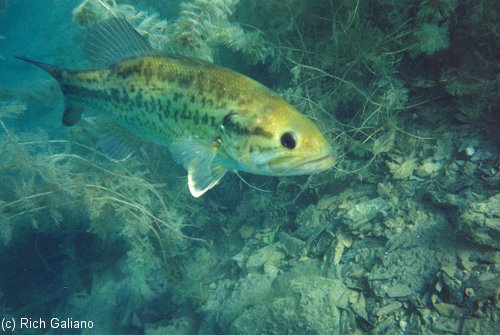
Largemouth Bass prefers clear, nonflowing waters with aquatic vegetation where food and cover are available. They occupy brackish to freshwater habitats, including upper estuaries, rivers, lakes, reservoirs, and ponds. Also, they can tolerate a wide range of water clarities and bottom types, prefer water temperatures from 65 to 85°F, and are usually found at depths less than 20 feet.
Spawning occurs from December through May but usually begins in February and March in most of Florida when water temperatures reach 58 to 65°F and continues as temperatures rise into the 70s. The male builds saucer-shaped nests 20 to 30 inches in diameter by placing its lower jaw near the bottom and rotating around this central location. Bass prefer to build nests in hard-bottom areas along shallow shorelines or in protected areas such as canals and coves. Depending on her size, the female can lay up to 100,000 eggs, which are fertilized as they settle into the nest. After spawning is completed, usually five to 10 days, the male guards the nest and eggs and later the young (sometimes called fry) attacking anything that approaches the nest. The female bass stays near the nest or may swim a short distance and remain listless for up to a day. After hatching, the fry swim in tight schools, disbanding when the small fish reach a length of about one inch.
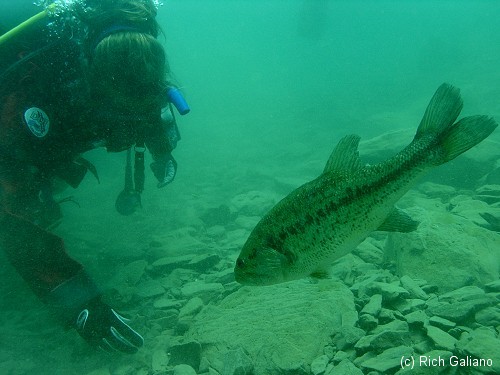
The diet of bass changes with its size. Young fish feed on microscopic animals ( zooplankton ) and small crustaceans such as grass shrimp and crayfish. Fingerling bass feed on insects, crayfish, and small fishes. Adult bass will eat whatever is available, including fish, crayfish, crabs, frogs, salamanders, snakes, mice, turtles, and even birds.
Growth rates are highly variable with differences attributed mainly to their food supply and length of the growing season. Female bass live longer than males and are much more likely to reach trophy size. By age two or three, females grow much faster than male bass. Males seldom exceed 16 inches, while females frequently surpass 22 inches. At five years of age, females may be twice the weight of males. One-year-old bass average about seven inches in length and grow to an adult size of 10 inches in about 1-1/2 to 2-1/2 years. The oldest bass from Florida whose age has been determined by fisheries biologists was 16 years of age. Generally, trophy bass (10 pounds and larger) are about 10 years old. The formula used by Florida scientists to estimate weight based on length and girth is: log(weight, in grams) = -4.83 + 1.923 x log(total length, in mm) + 1.157 x log(girth, in mm).

Smallmouth bass is similar, but the mouth does not extend behind the eye. Actually, their mouths are about the same size, it's more a matter of eye placement. North American freshwater basses are much more closely related to Sunfish than to Sea Basses.

